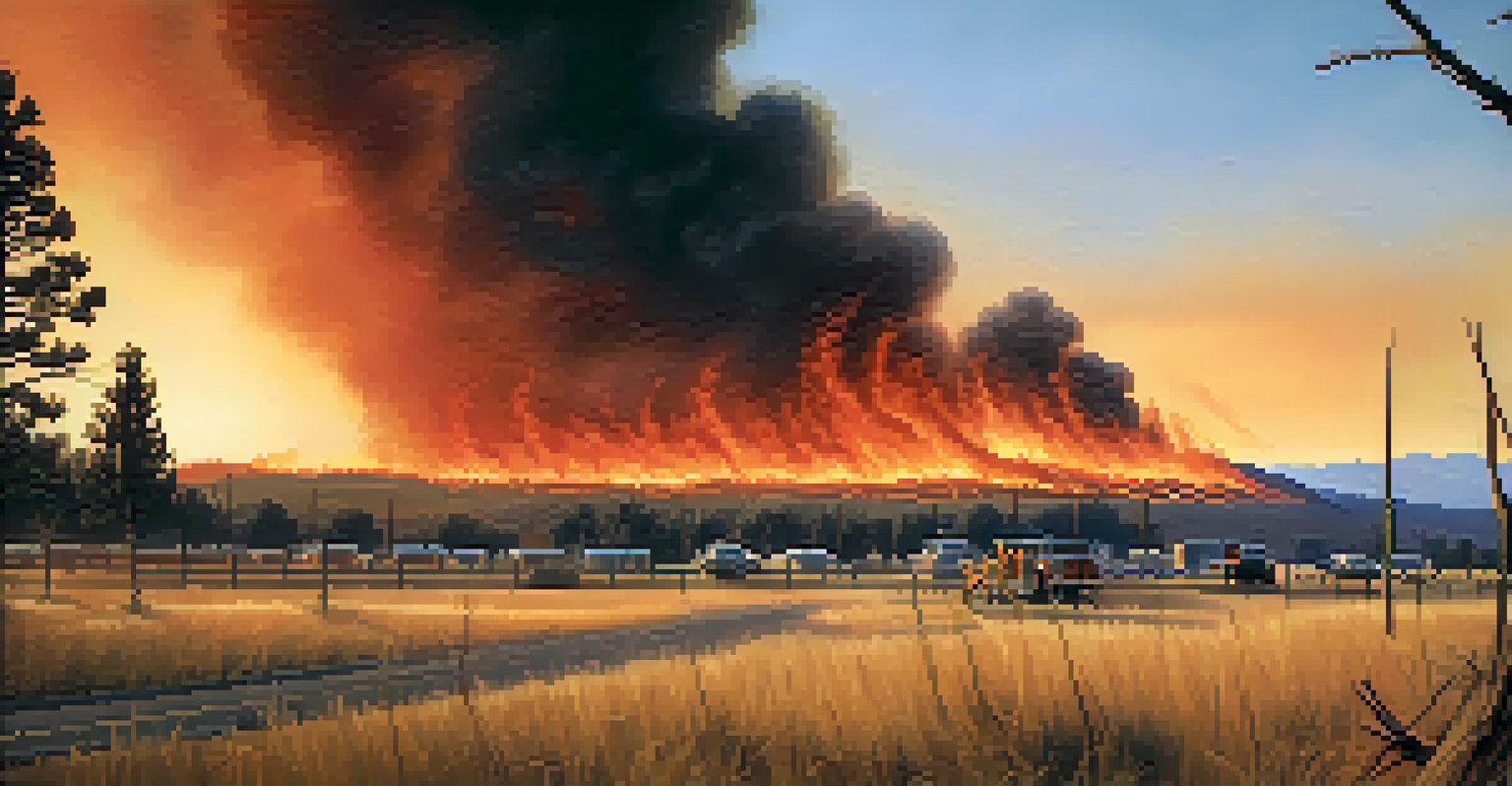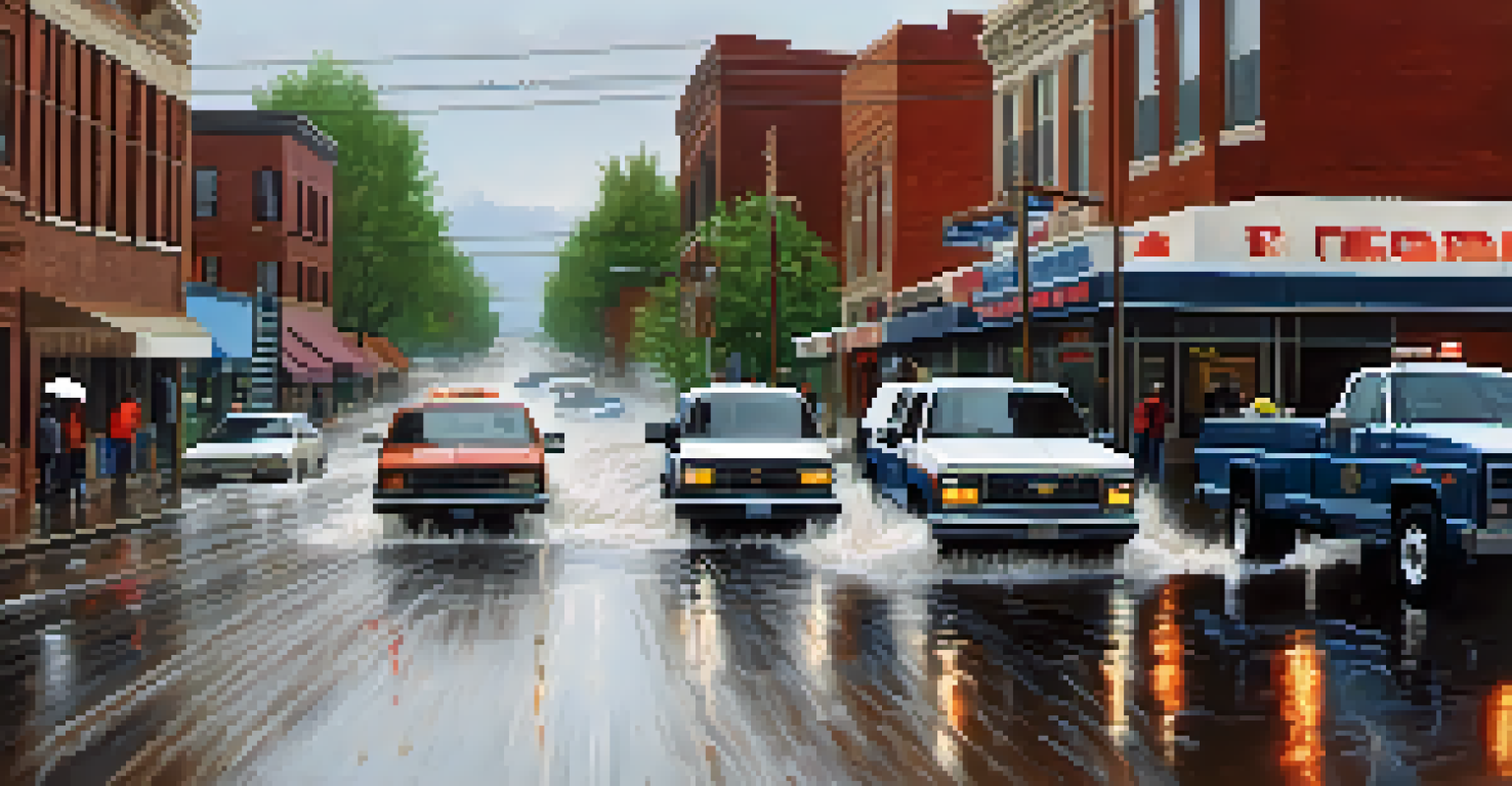Understanding Natural Disasters: Colorado's Most Common Risks

Colorado's Diverse Geography and Natural Hazards
Colorado's stunning landscapes, from mountains to plains, create a unique environment that is both beautiful and prone to natural disasters. The state's geography plays a significant role in the types of risks residents face, including wildfires, floods, and blizzards. Each region has its specific hazards, shaped by elevation, climate, and local ecosystems. Understanding these geographical influences helps communities prepare for and respond to potential threats.
The best way to predict the future is to create it.
For instance, the mountainous areas are especially susceptible to wildfires during dry seasons, while the Front Range can experience intense thunderstorms that lead to flash flooding. Additionally, the high-altitude terrain can create conditions for snowstorms and avalanches. By recognizing the interplay between geography and natural disasters, Coloradans can better equip themselves for emergencies.
Moreover, awareness of local terrain can aid in disaster preparedness and recovery efforts. Knowing whether you're in a flood zone or wildfire-prone area allows residents to take proactive steps, such as creating emergency plans or investing in home safety measures. Ultimately, understanding Colorado's diverse geography is the first step in mitigating risks associated with natural disasters.
Wildfires: A Growing Threat in Colorado
Wildfires have become one of Colorado's most pressing natural disaster risks, especially in the summer months. Factors like dry conditions, high winds, and abundant vegetation contribute to the intensity and frequency of these fires. Areas like the Colorado Springs and Boulder regions often make headlines during wildfire season, highlighting the urgent need for awareness and preparedness.

For example, the devastating Black Forest Fire in 2013, which destroyed over 500 homes, serves as a stark reminder of how quickly wildfires can escalate. Residents in high-risk areas are encouraged to create defensible space around their properties and stay informed about local fire bans. By understanding the causes and consequences of wildfires, individuals can take necessary precautions to protect themselves and their homes.
Wildfires Demand Community Action
Residents in high-risk areas must engage in fire safety practices and community initiatives to mitigate the growing threat of wildfires.
Additionally, community initiatives such as fire mitigation programs aim to educate residents on best practices for fire safety and prevention. These programs can empower Coloradans to work together in minimizing wildfire risks, fostering a sense of community resilience. Simple actions, like participating in local clean-up days or attending educational workshops, can significantly impact reducing wildfire hazards.
Flooding Risks: Understanding the Causes and Effects
Flooding is another significant natural disaster risk in Colorado, often resulting from heavy rainfall or rapid snowmelt. The state's varied climate can lead to sudden storms that overwhelm drainage systems, especially in urban areas. For instance, the 2013 floods in Boulder County showcased how quickly a calm day could turn into a disaster, with many residents caught off guard by rising waters.
Preparedness is the key to addressing any disaster, be it natural or man-made.
It's crucial for Coloradans to understand the different types of flooding, such as flash floods, which can occur with little warning. Local authorities often issue flood warnings, so staying informed about weather conditions is vital. Homeowners in flood-prone areas should consider flood insurance and have an emergency plan in place, as these preparations can make a significant difference in safety and recovery.
Moreover, communities can invest in infrastructure improvements, like enhancing drainage systems or creating flood plains, to mitigate flooding impacts. Collaboration between local governments and residents can lead to effective solutions that address both immediate and long-term flood risks. By understanding the causes and effects of flooding, Coloradans can be better equipped to handle this natural disaster.
Severe Weather: Storms and Their Impact in Colorado
Severe weather events, including thunderstorms, hailstorms, and tornadoes, are common in Colorado, particularly during the spring and summer months. These storms can develop rapidly, bringing dangerous conditions that pose risks to life and property. For instance, hailstorms can cause extensive damage to vehicles and homes, while tornadoes, although less frequent, can be devastating when they do occur.
Understanding the signs of severe weather and having a plan in place is essential for staying safe. Many Colorado residents rely on weather apps and local news to stay updated on storm warnings, ensuring they can seek shelter when needed. By being proactive, individuals can significantly reduce the risks associated with severe weather events.
Flood Preparedness is Vital
Understanding the types of flooding and having a solid emergency plan can greatly enhance safety for Coloradans during flooding events.
Additionally, communities often organize storm preparedness workshops to educate residents about safety measures and emergency procedures. These initiatives can foster a culture of readiness, encouraging individuals to be proactive rather than reactive. By understanding the potential impacts of severe weather, Coloradans can better protect themselves and their loved ones.
Snowstorms and Blizzards: Preparing for Winter Challenges
Colorado's winters can bring severe snowstorms and blizzards, which pose unique challenges for residents. The state's elevation and mountainous terrain can lead to heavy snowfall and rapidly changing weather conditions. Snowstorms can disrupt daily life, affecting travel, power supply, and emergency services, making it essential to be prepared for winter weather.
For example, the infamous blizzard of 2003 resulted in record snowfall across the state, leading to significant transportation issues and school closures. Understanding how to prepare for such events is crucial; residents should stock up on essential supplies, have a reliable heating source, and know how to safely navigate snowy conditions. By planning ahead, individuals can ensure their safety during winter storms.
Moreover, community resources, such as snow removal services and emergency hotlines, play a vital role in helping residents cope with severe winter weather. Local governments often provide information on road conditions and safety tips to help residents stay informed. By fostering a strong sense of community and preparedness, Coloradans can face winter challenges with confidence.
Earthquakes: A Lesser-Known Risk for Colorado
While Colorado is not typically associated with earthquakes, the state does experience seismic activity that residents should be aware of. The Front Range and areas near the Colorado Rockies have recorded minor earthquakes, reminding us that no place is entirely free of risk. Understanding the basics of earthquake preparedness can significantly improve safety during these rare events.
For instance, knowing how to 'Drop, Cover, and Hold On' during an earthquake can make all the difference. While the likelihood of a significant earthquake is relatively low, being prepared can help ease anxiety and ensure safety. Homeowners can take precautions, such as securing heavy furniture and creating emergency kits tailored to their families' needs.
Community Resilience Matters
Building a culture of preparedness through community engagement and education significantly improves responses to natural disasters.
Additionally, local authorities often provide resources and training on earthquake preparedness and response. Engaging in community drills and discussions can foster a culture of preparedness, encouraging residents to take natural disasters seriously, even those that may seem unlikely. By understanding the risks and preparing accordingly, Coloradans can feel more secure in their homes.
Mitigation Strategies: How to Stay Safe in Colorado
Mitigation strategies are essential for reducing the impact of natural disasters in Colorado. These strategies include planning, education, and infrastructure improvements that help communities prepare for and respond to emergencies. By implementing effective mitigation practices, residents can minimize risks and protect their families and property.
For example, creating a family emergency plan that includes evacuation routes, communication strategies, and supply lists can significantly enhance safety during a disaster. Communities can also invest in infrastructure upgrades, such as better drainage systems or wildfire prevention measures, to mitigate hazards. Educating residents on local risks and safety tips fosters a culture of preparedness and resilience.

Furthermore, engaging in community programs and initiatives can strengthen local responses to natural disasters. By participating in workshops, volunteer opportunities, and neighborhood meetings, residents can work together to develop comprehensive disaster plans. Ultimately, a proactive approach to mitigation can save lives and reduce the impact of natural disasters in Colorado.
The Importance of Community Preparedness and Awareness
Community preparedness is crucial in effectively responding to natural disasters in Colorado. When residents come together to create a culture of awareness and readiness, they significantly enhance their chances of safety and recovery. Community engagement initiatives, such as disaster response teams and neighborhood watch programs, play a vital role in building resilience against natural hazards.
For instance, local organizations often host events to educate residents about disaster preparedness, offering workshops and resources tailored to specific risks. By fostering a sense of community, individuals are more likely to support each other during emergencies and share valuable information. This collaborative spirit can make a significant difference in how communities respond to natural disasters.
Moreover, social media and local networks can be powerful tools for disseminating information quickly during emergencies. Residents can stay informed about weather alerts, road conditions, and safety tips, ensuring they are prepared for any situation. By prioritizing community preparedness and awareness, Coloradans can work together to face the challenges posed by natural disasters.